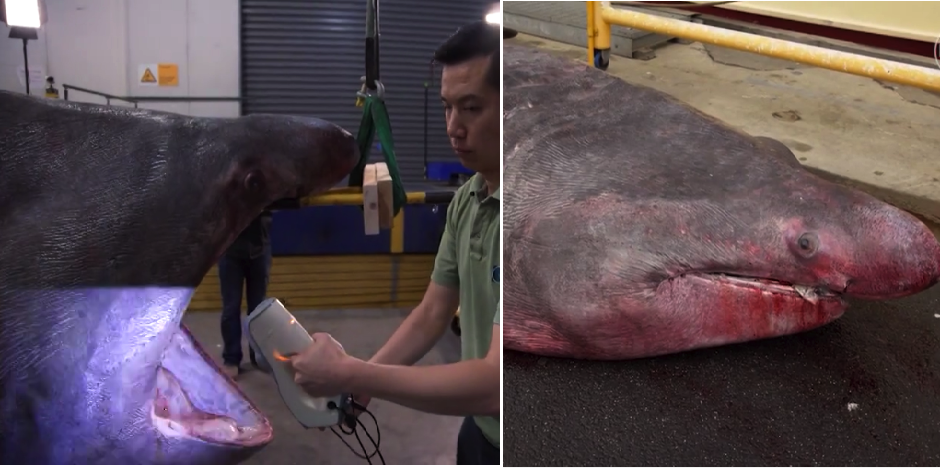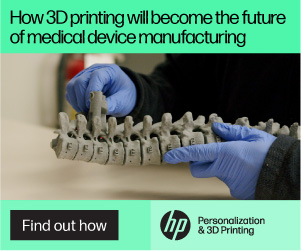The combination of 3D scanning and printing is changing the way we preserve our past. Two dimensional photographs used to be the best way to chronicle past discoveries, events and research, but over the last several years the emergence of highly accurate 3D scanning equipment and the subsequent ability to 3D print the data obtained from those scanners has presented a way to replicate the past. Whether it’s a bust of President Obama while in office, or an artifact destroyed by terror groups around the world, these technologies are changing the way that those in the future can tap into our current time.
Recently these technologies came into play after researchers in Australia unexpectedly came upon the specimen of a rare basking shark. It was just a couple of weeks ago when a fishing trawler accidentally caught the shark in the Bass Strait off of the coast of Portland, Victoria, in Southeast Australia. Unfortunately the fish got caught up in their nets and did not survive.
Basking sharks are often sought after for their fins, used in shark fin soup. Those who caught the giant fish, however, didn’t want this rare 20-foot long, 7,716 pound specimen to goto waste. They decided to donate the shark to the Museum Victoria for research.
Upon receiving the giant fish, which happens to be the second largest living species of fish after the whale shark, Museum Victoria decided to preserve it for centuries to come via highly advance 3D scanning and printing technology.
“This is the first time we have done 3D scanning at the museum, certainly at this scale,” said Martin Gomon, the museum’s senior curator of ichthyology. “We can compare their morphology with fish from other areas to see if they are a different species or how they are related to other species. The internal structures can also be X-rayed or CAT-scanned, so they are very valuable.”
 Because of the fish’s sheer size, researchers decided to remove most it its dorsal, anal, pectoral and pelvic fins, as well as some of its vertebrae. This left them with the head and gills, which they meticulously began scanning with a handheld 3D scanner. The scanner, operated by 3D scanning engineer Ben Tam, from the scanning company Qubic, could cover about a meter every 4 seconds and was able to capture 10-15 frames a second. Once the entire head, inside of the mouth and inside of the gills are scanned to the best of Tam’s ability, the museum will be 3D printing a replica of the head for public display.
Because of the fish’s sheer size, researchers decided to remove most it its dorsal, anal, pectoral and pelvic fins, as well as some of its vertebrae. This left them with the head and gills, which they meticulously began scanning with a handheld 3D scanner. The scanner, operated by 3D scanning engineer Ben Tam, from the scanning company Qubic, could cover about a meter every 4 seconds and was able to capture 10-15 frames a second. Once the entire head, inside of the mouth and inside of the gills are scanned to the best of Tam’s ability, the museum will be 3D printing a replica of the head for public display.
How rare is the basking shark in this area of the world? Incredibly rare. In fact, it’s the first basking shark caught in the region since the 1930’s and only third ever caught since 1855. Despite its rarity within the region, these advancing technologies will soon allow museum goers to get an up close and personal view of the giant shark, and who knows, maybe even 3D print a replica themselves at home.
Let us know your thoughts on this preservation technique and what these technologies will ultimately mean for researchers moving forward. Discuss in the 3D Printed Basking Shark forum thread on 3DPB.com.
Subscribe to Our Email Newsletter
Stay up-to-date on all the latest news from the 3D printing industry and receive information and offers from third party vendors.
You May Also Like
Why Corrosive Resistant Materials Are Important to the Success of 3D Printing Across Industries
The adoption of additive manufacturing (AM) is accelerating across many major industries. As this technological shift unfolds, the importance of corrosion resistance has emerged as a challenge for 3D printing...
America Makes Announces IMPACT 2.0: $6.6M in New 3D Printing Funding
America Makes, the Manufacturing Innovation Institute (MII) based in Youngstown, Ohio, has announced IMPACT (Improvement in Manufacturing Productivity via Additive Capabilities and Techno-Economic Analysis) 2.0, a project call which will...
3D Printing Webinar and Event Roundup: April 14, 2024
We’re starting off the week’s 3D printing webinars and events at ASTM AMCOE’s 11th Snapshot Workshop and MACH Exhibition. Stratasys continues its advanced training courses, SME is holding a virtual...
AMUK Welcomes Airframe Designs as British 3D Printing Industry Grows
While the UK is not the hub for 3D printer and materials manufacturers as other nations, the country continues to excel at the research, development, and application of additive manufacturing...
































